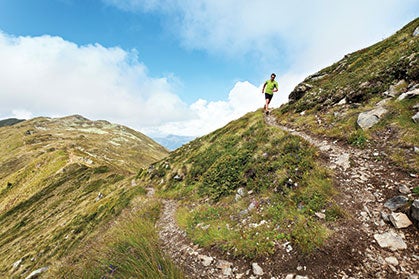Ask the Coach: Altitude, Cramps and Running Flats

Training at altitude; battling the “runner’s trots”; choosing the right terrain for recovery runs after an injury
Photo by Patitucciphoto.
WHEN IN DOUBT, GO HIGHER
I’m planning to run the Tahoe Rim Trail 50-miler (TRT50). Here’s the rub: The majority of my training is at elevations between 270 and 3100 feet. The TRT50 averages 8500 feet. So, I’m planning on taking a running vacation to train at higher altitudes before the TRT starting gun. Is this a good strategy, and what are problems that can be expected for high-elevation races?
—David Leeke, Nevada City, CA
At higher altitudes there is less oxygen in the air, which means each breath delivers less oxygen to working muscles. Sports physiologist Leslie Shooter of Salt Lake City, Utah, says this can cause a number of problems, including “elevated submaximal heart rates, increased ventilation, increased perceived level of exertion, lightheadedness, dizziness, headache and fatigue,” among many others.
Of the many altitude-training theories, one proven method involves arriving at the race altitude before the event to acclimate. However, a minimum effective acclimation period is hard to assign because of genetic variation, and some people do not respond at all. And most folks living at lower elevations don’t have the luxury of taking time off prior to a race.
Your planned vacation at higher altitude may be a great way to tackle the problem of living low and racing high. It also fits with the current trend of periodization in altitude training. This simply means you take a block of time to train at altitude, then give your body a block of time at lower altitude to recover. Your body responds to the stress of being at altitude by producing more red blood cells, and research shows that 10 to 14 days after your exposure, your red blood cells will be at their highest. So, if possible, schedule your race about two weeks after your altitude vacation. When racing or training at altitude, says Shooter, “Pay extra attention to hydration and include electrolytes in fluids upon arrival.” This will help maintain plasma volume, which will ease the work required for your heart to pump enough oxygen-rich blood through the body. She also suggests keeping your muscle and liver glycogen topped off by eating more carbohydrates, since your body will be utilizing more glucose at altitude.
TROTTING ALONG
I have been experiencing what is commonly referred to as the “runner’s trots”—stomachache followed by a need to use the bathroom. It normally happens around mile nine or 10, and either cuts my run short or forces me to have “more intimate contact with nature.” I have tried cutting back on fiber before long runs, hydrating more and avoiding fats, but nothing works.
—Viviana Delgado, Alexandria, VA
The age-old problem of “runner’s trots” needs to be reexamined in light of what we now know about our micro-biomes and gut permeability. Says sports nutritionist Ben Greenfield of BenGreenfieldFitness.com, “In most athletes, runner’s trots are due to poor intestinal health, rather than simply consuming too many calories or too much fiber.”
When your stomach lining becomes damaged, or permeable, it allows food particles to pass through the intestinal cell wall and into your bloodstream. Your body responds by mounting an autoimmune response; unfortunately the quickest way to rid the body of these invaders is diarrhea.
Food allergies are a common cause, but certain antacid drugs can thin the stomach lining, making gut damage more likely. Avoid grains, dairy and beans; these foods (especially when left unsoaked or unsprouted) contain protective agents called lectins, which bind to and compromise the stomach villi.
Greenfield says certain foods can strengthen the integrity of the gut cell wall, including bone broth, collagen, colostrum, probiotics and fermented foods such as Kim Chi, kefir, sauerkraut and natto.
FLATS FOR RECOVERY?
After a meniscus injury, I am slowly building up to running again with a combination of run-walking on both grass and pavement. But should I train on only flat surfaces during my recovery?
—Mimi Hart, Cedar Rapids, IA
The meniscus is the padding that lies in your knee between your femur and tibia. It disperses the impact when you run or walk, and lessens the friction of knee movement. It can be damaged in several ways; a meniscus tear usually accompanies an MCL or ACL tear. For runners an inappropriate training load—too many miles too fast—can be the culprit.
Meniscus tears usually present as catching, popping or general pain in the knee. The meniscus receives very little blood flow, and won’t heal without surgery. So if you’ve been dealing with this injury for more than six months without improvement, see a specialist.
During recovery, says U.S. Ski Team physician and orthopedic surgeon Mark D. Scholl, “I prefer the variety that running hills and trails provide over a flat workout. Flat roads tend to keep a runner at the same cadence and stride, loading and stressing the same tissues without spreading the work.”
This article originally appeared in our September 2013 issue.